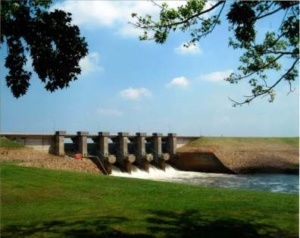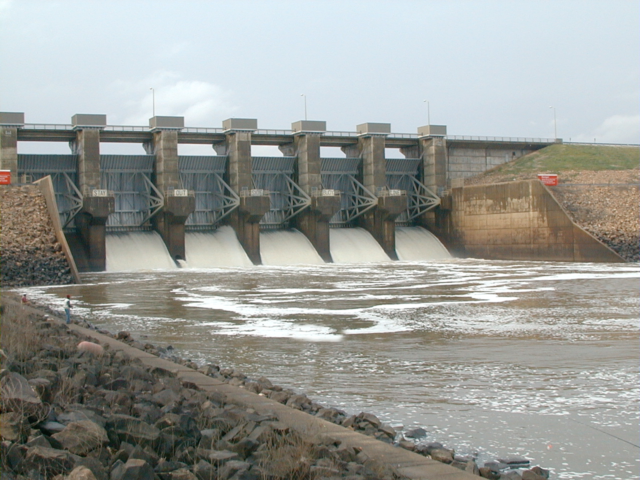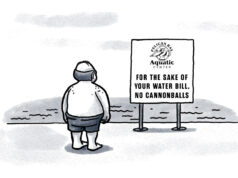Water is a big deal.
Nations go to war over water. States fight incessantly about water quality and transfers. There is a significant body of federal and state law that controls water.
In this context, and with Oklahoma occasionally passing in and out of drought conditions, it is common for state officials, political commentators and the media to suggest that Oklahoma faces a significant challenge in regard to water.
For those of you who believe that Oklahoma faces water-supply challenges — or for those who may not think so much about such scintillating public policies — I want to suggest a road trip for you.
Hugo, Oklahoma, (population 5,310) is 200 miles and three hours to the south of Oklahoma City. Hugo has to be the only Oklahoma town named after a French novelist. During part of its history, it served as the winter quarters for circus performers (which explains a lot — just kidding). Actually Hugo is a great community, has a strong paper and publisher, and frequently punches above its weight.
In addition to enjoying a weekend cabin at the Hugo Lake State Park (which no longer receives any state funding), wander over to the overlook at the Hugo Lake Dam. Spend an hour or so enjoying the view of the lake and surrounding area. What you will see is, according to Oklahoma Water Resources Board estimates, an average of 54 million gallons of water going over the spillway while you are standing there. This hour’s worth of water overflow takes a 15-mile trek down the Kiamichi River and spills into the salt-contaminated brine of the Red River.
Oklahoma’s discharge: 30 billion gallons per day
Let’s put a pencil and calculator to that one-hour volume of what The Oklahoman calls “the nation’s best water.” The calculator adds up to half a trillion gallons, or, if trillions aren’t your thing, 500 billion gallons. Or, for the water experts, it is 1.5 million acre-feet going over the Hugo Dam every year and being wasted.
For some perspective, the 1.35 billion gallons of water a day going over the Hugo Dam in a community of 5,000 people is 30 percent more than the daily consumption of New York City’s 8.5 million residents in 2015.
Holy cow! That is a lot of water. How could we be “losing” that much water every year in a single Oklahoma county?
What? There’s more?

The publisher of the Hugo News, Stan Stamper, is a walking Wikipedia on southeastern Oklahoma water. He told me recently that the Muddy Boggy River, just west of Hugo, which does not have but should have a reservoir, flows even more water into the Red River: an estimated 1.6 million acre-feet annually (or another 500 billion-plus gallons of water every year). Some of the locals call this Muddy Boggy Creek. That is one hell of a creek.
So from one Oklahoma county, Choctaw County, spills into the Red River nearly three times the water consumed by 8.5 million people in New York.
Wait! There is even more. Documents submitted during a Supreme Court case in 2013 about Oklahoma water established that while Oklahomans consume 2 million acre-feet of water annually, they “discharge unused” into the Red River 34 million acre-feet, or 17 times more than Oklahoma consumes. This converts to about 30 billion gallons per day.
The Oklahoma Water Resources Board has previously estimated that the amount of water departing Oklahoma via the Red River from all of the possible “collectible” points in southeast Oklahoma is about 26 billion gallons per day. Put another way: enough water to meet the daily needs of 25 New York Cities.
If we can agree that the Russians messed with our national elections, then surely we can agree that Oklahoma is AWASH in vast amounts of water, many times the needs of a state approaching 4 million residents (which, incidentally, took 100 years to grow from 2 million).
What is this water worth, if anything, and who would buy it?
While we hate them, Texans relatively bright
Funny you should ask. Across the Red River is an organization called the North Texas Water Association. (I know: We all hate Texans. It even transcends college football and NBA competition. Hating Texans is so politically popular in Oklahoma that we revere a former governor who declared war on them and put troops on the Red River bridge.)
As such, the idea of selling Oklahoma water to Texas stirs an ire that is intense and long-remembered. Most politicians in southeastern Oklahoma have either come from or long been supported by activists who vehemently oppose a sale of any water, excess or otherwise.
But we have to admit that Texans, while we hate them, constitute a relatively bright bunch. They have whipped up their economy to 10 times the size of Oklahoma’s, and they periodically elect themselves a president. They have a lot of resources.
What they don’t have in northern Texas (and in many other parts of Texas) is water. The North Texas Municipal Water District (NTMWD) serves 90 communities across the border from Oklahoma and is home to 1.6 million residents. The district is growing rapidly and expects to have 3.7 million residents in 50 years. This water district consumes about 325 million gallons a day. They project their consumption will grow to 500 million gallons per day by 2040.
I wonder what the North Texas Water District would pay for Oklahoma water?
Calculating the value of our excess water
Having been aware of this issue for nearly three decades, a good negotiator should be able to get $1 to $1.50 for a thousand gallons of water. I know Texas has offered much less several years ago, but $1 per thousand gallons is a reasonable value.
We won’t really know the price until we have a serious negotiation, but several years ago a New York Times Magazine story reported Colorado farmers sold water to Las Vegas for as much as $12,000 per acre foot. That’s the equivalent of $37 per thousand gallons.
For the moment, let’s assume our crack negotiators can get at least 3 percent of what some farmer in Colorado negotiated, and $1 per thousand gallons is a good price. (The North Texas Water District, by the way, sells water on a wholesale basis to its member cities for $2.53 per thousand gallons.)
One dollar per thousand multiplied by the Hugo Lake excess of 1.3 billion gallons per day is $474,500,000 annually. Nearly a half-billion dollars — annually!
(Pause for effect.)
Now let’s throw in that Boggy “Creek” water flow. That would add up to over $1 billion annually using the very competitive price of $1 per thousand.
OMG: I found another billion dollars annually for the state. Remember, there is 10 times this amount of water flowing into the Red River at collectible points in Oklahoma.
Calculating the potential demand
Before we build a pipe from Hugo Lake to a catchment lake in Texas and build a new reservoir at Boswell, Oklahoma, to collect the Muddy Boggy Creek water flow and connect these with a pipe down to Lavon Lake near McKinney, Texas , let’s see how much Texas can or might buy.
The table below contains statistics of the excess water that Oklahoma generates and “discharges unused” into the Red River. Also, the table compares Oklahoma’s annual consumption to the volume of excess water in Oklahoma and contrasts it to Texas’ water consumption, which is currently nine times that of Oklahoma’s. If Oklahoma met ALL of Texas water consumption, it would only consume 55 percent of Oklahoma’s excess water currently being thrown away. Obviously, Oklahoma would never provide 100 percent of Texas’ need, but it is reasonable that Oklahoma could provide 25 percent over the next decade.
|
Oklahoma Excess Water Statistics |
Annual Flows (million acre-feet) |
Annual Flows (billion gallons) |
| Hugo Lake Dam |
1.5 |
489 |
| Muddy CENTER Creek |
1.6 |
521 |
| Other Collectible Points |
26.9 |
8,765 |
| Total |
30.0 |
9,775 |
| Oklahoma Annual Consumption (2007) |
1.8 |
587 |
| % of Okla. Annual Consumption to Okla. Excess Water |
6.0% |
6.0% |
| Texas Annual Consumption |
16.5 |
5,377 |
| % of Annual Texas Consumption to Okla. Excess Water |
55.0% |
55.0% |
After negotiating a contract and getting it cleared by the Oklahoma Legislature, there are many ways to approach a transaction on the sale of water to Texas. My suggestion is that the existing catchment of Hugo Lake be used to start the process and sell water to NTMWD. I suggest one go slowly in order to give the infrastructure on both ends time to catch up and allow the NTMWD a chance to integrate the supply into their needs.
NTMWD’s demand alone is not enough to make a dent in the excess water from Oklahoma, but Texas has huge water needs, and, as we know about Texas, “It is all downhill from here.”
Ignoring the attempted double entendre, the point is transporting water through lakes, rivers and pipelines to other critical needs in Texas is more efficient than trying to sell water uphill. The table below reflects that Oklahoma start by meeting about 5 percent of Texas’ water demand and grow over a few years to providing nearly 25 percent of the Texas need.
Oklahoma water sales plan to Texas
| Oklahoma Water Sales Plan to Texas | Year One (2020) | Year Two (2021) | Year Three (2022) | Year Four (2023) | Year Five (2024) |
| Rate per 1000 gal. | $1.00 | $1.20 | $1.45 | $1.75 | $2.00 |
| Sales Amount (1,000 gallon Units) | 100,000,000 | 200,000,000 | 300,000,000 | 400,000,000 | 500,000,000 |
| Sales Amount (billion gallons per year) | 100 | 200 | 300 | 400 | 500 |
| % of OK Total Excess | 1.054% | 2.107% | 3.161% | 4.215% | 5.269% |
| % of Hugo Excess | 20.459% | 40.918% | 61.378% | 81.837% | 102.296% |
| % of N.Texas WD | 120.048% | 240.096% | 360.144% | 480.192% | 600.240% |
| % of Total Texas | 4.650% | 9.300% | 13.949% | 18.599% | 23.249% |
| Income | $100,000,000 | $240,000,000 | $435,000,000 | $700,000,000 | $1,000,000,000 |
Here is the best news: 25 percent of Texas’ water needs is only 5 percent of Oklahoma’s estimated total excess water.
I am resisting the temptation to repeat this.
That is how much water we have. We can flow 500 billion gallons of water to Texas and get paid $1 billion escalating annually for this water. It is a great deal for Texas, and it is a huge new source of funding for Oklahoma. It only takes 5 percent of our excess water that we are currently just throwing away.
Water sales a historically ‘radioactive’ issue
This will not be easy. The sale of water to Texas is radioactive for no factually good reason, but we have to face the reality of the emotions involved.
My administration, during what we call the “enlightened period,” created the Department of Environmental Quality. As governor, I asked Patty Eaton, a brilliant, strong Tulsa woman, to run the Oklahoma Water Resources Board and to be Oklahoma’s first secretary of the environment. We faced a number of issues in reorganizing our environmental agencies, but one stands out clearly: the sale of water to Texas.
I recall one group of women, near Lake Sardis, upset about the possible sale of water to Texas. They donned T-shirts emblazoned with pictures of dead fish and attended a meeting I had in the region. This meeting was a forerunner of the modern-day Tea Party yell-a-thons.
Having about all the controversy that I cared to handle at the time, I asked Secretary of the Environment Eaton to abandon negotiations to sell water to Texas. Thus began a tradition that every political leader in Oklahoma has dutifully followed since, which is to strap on running shoes and sprint from this issue.
But we can no longer, as if we ever could, afford this luxury. Oklahoma is being dragged through a willful bankruptcy where the ideology of eliminating all taxes and shrinking government prevails over human compassion. Selling water will require new leaders looking for new and renewing resources to help Oklahoma sustain, grow and prosper.
‘God created escrow accounts’
You will note that, except for a few numbers and a little pricing research, I have taken a 40,000-foot view. I know there was a bitter fight at the U.S. Supreme Court; that there is a new water compact with the tribal nations and enough legal briefs to choke a horse; I know that southeast Oklahoma is still waiting for “its turn;” I know that poverty in the southeast Oklahoma area is dominant, per capita incomes are half of those in the cities, and that Hugo does not have a single dollar in their city budget for road improvements. And, of all the ironies, the biggest issue in many southeast Oklahoma communities is fresh water.
Imagine what we could do with our community water systems, wildlife conservation, economic development, green energy job parks and our general quality of life, particularly in southeast Oklahoma, if a significant portion of this funding stays in the region (as it should).
Here is some red meat for conservatives: Oklahoma could cut taxes and raise education funding simultaneously. It is literally, finally, one trickle-down theory that could work.
Imagine contributing $1 million each year to the 22-county regional Waste Water Plan, contribute $500,000 annually to the six-county economic development plan and contribute $250,000 annually to the Kaimichi Wildlife Development.
Feeling generous? Let’s double all of those amounts. You still have hundreds of millions annually, just from the Hugo Lake dam overflow, to divide between the state, the tribes and other water-related needs.
Now, you and I know families that can fight for a decade over a thousand dollars. How in the world will a state, tribes and other interested parties ever come together to distribute hundreds of millions if not billions of dollars?
Fortunately, that’s why God created escrow accounts. Cut your deal with Texas and put the money in a savings escrow. Eventually, figure out how to divide it. Trust me: When a few billion dollars accrues in the escrow account’s balance, the parties will find a way to come to some agreement.
So how do we do this? First, a Water Development Authority should be created that gives real voice to the stakeholders, the state, tribes, environmentalists, farmers, wildlife conservationists, the activists that oppose this so vehemently and, especially, the residents and their leaders in these catchment basins.
We should bond a portion of this cash flow and build the catchment infrastructure ourselves with Oklahoma companies and talent.
A hundred-million to a half-billion dollars of infrastructure development can be funded and paid for, creating a virtual boom in the southeast Oklahoma economy and the state. Contracts to sell this collected water can be flexible and can always, ALWAYS, give priority to Oklahoma’s needs. We simply convert the wasted water to cash until we need the water, if ever.
We can do this, or we can continue to despise Texans and throw our water away into the Red River.
If we decide to continue ignoring this opportunity, we should at least make an appropriation to the unfunded Hugo Lake State Park. This fund could establish a recreation area at the overlook of the spillway at Hugo Lake for folks who want to show their kids what it looks like to waste $1.3 million a day.























